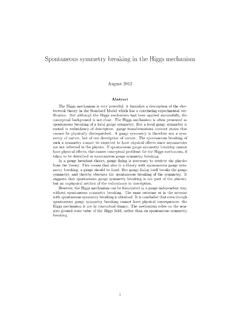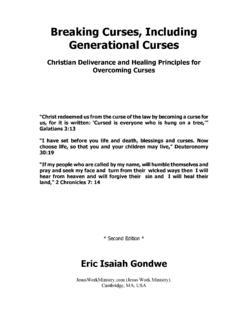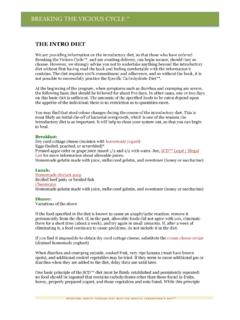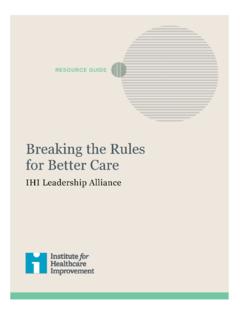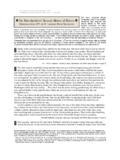Transcription of Breaking Barriers: Libraries and Socially Excluded Communities
1 Breaking barriers : Libraries and Socially Excluded Communities By Annette DeFaveri When we talk about barriers to library use the allusion is to a wall. When we talk about Breaking barriers the allusion is to a crumbling wall. But what keeps Socially Excluded people from using the library is not a physical barrier broken by a single well-placed hammer blow. The barriers are more subtle and insidious, and are ingrained in library culture. And they are most formidable for society's Socially Excluded groups. For every person who finds the library safe and pleasant there is another person who feels uncomfortable and unwelcome. This is a hard truth to accept, especially for people who see the library as one of society's truly accessible and democratic institutions. Identifying the barriers that keep Socially Excluded groups from using the library, understanding why the barriers exist, and finding ways to overcome the barriers is an iterative and generative process.
2 When the director of a local youth center was asked why the teens did not feel welcome at the library he replied, "Because they are not welcome." Teen behaviour, including loud conversations, overt displays of hormone-charged sexuality, and demanding yet sullen exchanges with adults make library staff uncomfortable, and they in turn attempt to restrict and regulate the teen's behaviour. The issue, he explained, is that teens are not going to change, so if the library is interested in welcoming teens it will have to change. The coordinator of a family refugee service was asked why newcomers did not attend library events or make use of free library resources. She said that the library's inherent cultural expectations regarding group behaviour were alienating for newcomers. In many cultures gatherings are times for discussions and socializing. Library gatherings are more formal and often have a classroom style and feel to them that discourages conversation and interaction, except with the librarian.
3 This approach presents the librarian as an authority figure who judges a newcomer's ability to assimilate, and who has the power and position to disapprove of a newcomer's behaviour. Feelings of inferiority and otherness result, and are transferred from the librarian to the library. Feeling unwelcome and alienated from the library is not limited to society's most marginalized groups. For many working class adults the library is as foreign an institution as a university or museum. Even relatively well-off working class people may not have a tradition of library use and so may feel that their lives, their values, and their concerns are not reflected in the culture of the library. What they do feel is the library's culture of authority and deference. The library is not seen as an organization that facilitates the acquisition of information or one that promotes life long learning.
4 For them the library's culture mystifies information and the process of acquiring information. The Working Together project talked with community members who do not use the library. Reasons for not using the library include: Reading is hard. You have to be a good reader to use the library. Feeling as if the library is a club and I'm not a member of the club. Feeling as if the library is like school and school is hard and not much fun. Believing that the library has good things, but feels too stupid to find them or ask for help. Afraid of asking the wrong question, or asking the wrong person the wrong question. Believing that the library is only for smart people. Feeling stupid at the library. Not understanding how the library works. Afraid to go in and ask for something in case it is something that everyone else knows how to find. Believing that the library is about books and do not read too many books.
5 How do we make the library a more welcoming and inclusive place for all community members? One way is to emphasize the importance of the library's initial contact with new patrons. On-line registration works well for people who are confident with technology. But for people who feel intimidated by automated services, and who have difficulty articulating their needs, even filling out a paper application can be isolating and discouraging. Welcoming new patrons and making them comfortable in the library should be the jewel in the service model crown. Librarians could register new patrons in person and take this opportunity to talk about the patron's reasons for coming in to the library, to ask if other family members need cards, and give a tour of the branch resources. This strategy personalizes the library and makes it immediately relevant in the life of the new user.
6 The library has been described as the living room of the community. But to be sure it is a hospitable living room the hosts must work to welcome their guests and see to their needs. Another simple but significant step is having patrons sit beside the librarian, rather than across the desk. Looking for information becomes a collaborative effort that demystifies the searching process. Working side by side with a patron highlights the library's teaching and instructional role without emphasizing the differences between those who know how the library functions and those who have difficulty using the library. A significant barrier to library use by Socially Excluded people is the need to feel comfortable with the library as a community space before feeling comfortable with the library as a community resource. Patrons must be and feel included in the ongoing and everyday activities of the library.
7 It is not enough to tell Socially Excluded groups that the library has significant resources freely available to them. Nor is it enough to tell them that the library is a supportive and respectful organization. Socially Excluded people know that what an organization claims it will do, and what it actually does, can be very different things, and that this difference rarely works in their favour. In his radio play "Dead Dog Caf " Tom King illustrates this dichotomy by telling the story of two First Nations people who, on Halloween, go trick or treating as the scariest people they know a social worker and a priest. Poverty, mental and physical illnesses, limited education and refugee status are just some of the conditions that shape the lives of Socially Excluded people and inform their perceptions of community services. Each of these conditions can engender suspicion of authority, isolation, and non-participation.
8 Often these conditions are reinforced by degrading and alienating encounters with other institutional community agencies. It is easy and common to include Libraries with other authoritarian, alienating, and excluding community organizations. As a result Socially Excluded people are often unwilling to enter a library and unlikely to use its resources. The library needs to demonstrate that is a respectful and inclusive organization before it can convince Socially Excluded groups that it offers collections, services, and programs that can enrich and empower their lives. This was the situation that the Working Together project faced with LOVE (Leave Out Violence), a community group that supports young adults who are the witnesses, victims and perpetrators of violence. The young adults who attend the LOVE Leadership class knew about many of the programs and services the library offers, but were not using them.
9 Talking with the Leadership class revealed that they associated the library with school, which was often hostile and isolating. They felt that, like their schools, the library was an authoritarian institution imposing its values and behavioural norms on them. The challenge for the Working Together project was to show LOVE young adults that the library is an inclusive and respectful organization that strives to represent and include all community members. To do this LOVE young adults were invited to hold their graduation ceremony at the library. The library also hosted an evening of readings by LOVE members and installed LOVEs original photographs in the Moat Gallery for the first two weeks of 2005. Once the young adults felt comfortable in the library, once they believed that they were part of the community entitled to use the library, the library could offer access to its collections, programs, and services.
10 By first becoming an inclusive community space the library is able to encourage Socially Excluded people to explore its diverse resources. And by using the library's resources, Socially Excluded people are more likely to enrich and empower their lives. As they begin to enrich and empower their lives they are more likely to participate in the community and become active, able citizens. One suggestion for promoting the library as an inclusive community space is to create a programming series and template that facilitates the use of library space for community programs that may not have an obvious or immediate connection to the library's collections and services. Developing such a series creates an opportunity for promoting other library programs, services, and collections to those community groups it does not normally reach. Another suggestion is to establish book clubs that meet in community buildings such as neighbourhood houses and focus on the clientele of the neighbourhood organization.

